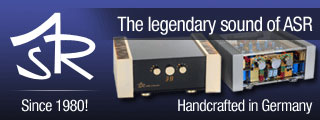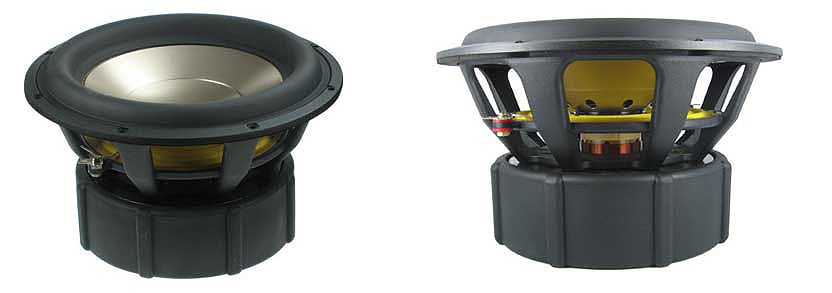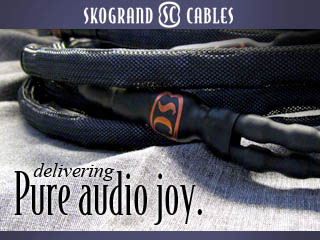Listening
In my experience, wideband drivers tend to have two problems. First, they have a distinctive sound, which a friend describes as sounding like a kazoo; my suspicion is that this is a function of the wizzer cone. Second, many widebanders also have nasty upper frequency peaks, typified as the “Lowther shout.” Much to my delight, the Troika is devoid of these distinctive colorations. In fact, if I were to use a single adjective to describe the Troika’s sonics, it would be “relaxed.” I assume this is a function of the A3 not having a wizzer cone, and of Vadim’s decision to set the crossover point to the ribbon below the A3’s breakup points. But whatever the reason(s), the effect is most welcomed, as the Troika, unlike many widebander-based speakers, does not induce listener fatigue.
In one regard however, the Troika is typical of widebander-based speakers: It has superb coherence. As I’ve said in past articles, lack of coherence is often not noted as such, except in very poor designs, until one hears a truly coherent speaker. No matter how carefully different drivers are selected, and no matter how good the crossover, it is virtually impossible to obtain coherence as good as that provided by a speaker that functions as a point source for most of the frequency range. As noted, the upper A3 covers the range from about 8 kHz down to the user-selected crossover to the Olaf woofer, which will be typically be around 200 Hz; this driver thus covers the entire critical midrange, as well as lower high frequencies and upper bass frequencies.
As noted, the lower A3 provides some boost up to about 1 kHz, but as this driver has identical dispersion and “sound” as the main driver, it does not appreciably, if at all, diminish the coherence. The consequences of this coherence is that the music sounds — well, coherent — or as its often described, as being of one piece. This allows one to more readily focus on the music, rather than disparate parts that would otherwise call attention to themselves. The Troika’s coherence, combined with its well constructed cabinet, i.e. one with rounded corners to minimize diffraction, and the small size of the A3 driver, together provide excellent and stable images. Taken together, this allows the speaker to get out of the way, adding to the illusion that one is listening to actual musicians, rather than to a recording.
Tonally, the best test of a wideband or midrange driver is human voice, and in this regard the A3 acquitted itself quite well. Voices were, with appropriate upstream gear, smooth, natural, vibrant, and harmonically rich. This was true of both male and female vocals.
Ribbon tweeters are praised for their speed and detail, but can be difficult to blend with traditional cones and domes. However, the transition from A3 to the LCY-K100 was excellent, rarely calling any attention to itself, this a testament to the design of the passive crossover. I am very sensitive to upper frequency distortion, and I am thus leery of ribbons. However, the LCY-K100 proved to be very competent. Horns had good bite and attack, but never sounded harsh. In fact, if anything I found the ribbon to be a touch reticent. I discussed this with Vadim who explained that this particular pair of speakers was voiced for Rob’s personal taste, which necessitated adding a larger resistor to the ribbon so as to slightly lower its output. Case in point, a resistor is required to lower the efficiency of the ribbon to match that of the A3. I thus assume that the standard Troika would have just a bit more air and extension than the review pair.
The Troika/Olaf has good dynamics, scaling up nicely with large orchestral works. However, the lower mids/upper bass could use a bit more punch. Varying the Damping adjustment allowed us to add a bit of boost at the crossover point, which clearly helped. This also allowed us to lower the crossover point, which made the coherence even better. However, even when optimally adjusted, there is less energy in this region that I would like. It should however be noted that I prize dynamics above many other sonic parameters. I discussed this issue with Vadim who explained that this is the downside of the A3’s relatively small diameter. But as noted above, that same small size adds to the smooth transition to the tweeter, and provides excellent imaging; so as with most things in audio, there are trade-offs.
Now, we come to the Olaf woofer. Bass reproduction is complicated, and it is fair to say that it is an area in which most high-end speakers compromise, often to a considerable degree. The compromises are the result of the intersection, or more aptly, clash of the laws of physics with practical limitations. Deep powerful bass places considerable demands on the choice of the woofer and the cabinet, as well as the amplifier. While appropriate drivers are not inexpensive, it is the cabinet that poses the larger problem, both literally and figuratively. In a perfect world, we would want a woofer with small cabinet size, deep bass and high sensitivity; Hoffman’s Iron Law teaches that we can choose two, at the expense of the third. Most high end speakers forego deep bass, and use a bass reflex design that boosts output at the port frequency, with rapid roll-off below that. This is practical because smaller cabinets translate to higher Spouse Acceptance Factor and lower costs; moreover, a bit of boost at the port frequency gives the illusion of bass deeper than it really is. The downside is that in most cases the bass isn’t truly deep, the ports often add their own sound, and such designs have poor transient response. Vadim feels that any decent speaker must be capable of reproducing bass at least into the 20 Hz range, and must do so with superb transients. To achieve this he chose to use a sealed box. As he was cognizant of SAF, he used a cabinet of modest proportions, but compensated for this with a Linkwitz transform equalization circuit, the details of which are over my head, and beyond the scope of this review. For interested readers, an excellent description can be found here. Vadim also paid careful attention to the woofer, as it had to have just the right Q (“Quality factor”) to work properly in such a configuration. As noted above, Vadim collaborated with Phil Marchand on the amplifier and crossover, including the Linkwitz transform.
Before I turn to Olaf woofer’ sonics, I want to repeat something I said in my recent review of the Surreal Sound Fifth row speakers: In my opinion, every speaker should use an active crossover/adjustable amp for the bass. The benefits of relieving the main amp of powering the woofer, having no passive crossover between the amp and woofer, and being able to adjust the woofer for the room, can simply not be overstated.
I can sum up the Olaf woofer’s sonics in just a few words: It produced the deepest, most articulate bass I have experienced in my room. My favorite bass player is Hilliard Greene, who I have had the pleasure of hearing live on numerous occasions. I often use his Alone CD to evaluate a system’s bass. Until listening with the VB Olaf/Troika, I was unaware of how much information I had been missing. Never has bass sounded this good, or this real. This was true of every bass track I listened to. Each and every note was clear and incisive, and with double bass in particular, the harmonics were rich and lush, but never bloated. This is bass done right!
Concluding Remarks and Future Directions
The VB Olaf/Troika is a very impressive speaker. It is hand built to order in Princeton, New Jersey, is solidly constructed, attractive in an understated way, and relatively small considering its full-range performance. It provides the benefits of a wide-band speaker, yet is full-range. Moreover, it is tube-friendly, and can easily be powered by amps producing as little as 30 Watts. It’s relaxed sound will appeal more to those who just want to enjoy the music, than to those who want to hear each and every nuance. The Troika and Olaf can be order together or separately; the MSRPs are $5,000 and $8,500, respectively and $13,500 for the pair. Additional speakers, single or in pairs, are available for those with 3 or 5 channel set-ups. Vadim is offering an Introductory 15% discount, thus $4,250 for the Troika and $7,225 for the Olaf (($11,465 for the pair). Optionally, it can be ordered with any wood veneer, a variety of finishes, such as stain/poly, stain/pre-catalyzed lacquer, or no stain at all; the review pair was done in wax with no poly or lacquer stain. For readers looking to save some money, it can also be ordered with less expensive crossover parts. In my opinion, it is an excellent value for the money; with the discount, it is a true bargain.
Vadim makes a number of other models; one that I heard that was quite intriguing uses a Manger driver and LCY-K100 ribbon, sitting atop an Olaf-style woofer. It, too, is very coherent, but with greater impact than the Olaf/Troika. Vadim is also working on a larger Olaf woofer, which would use a 12” driver in a larger cabinet. While this would provide even greater bass output, its main benefits will be lower distortion and the ability to accommodate a larger top unit. I hope to report on new models as they become available.
- ← Previous page
- (Page 3 of 3)



